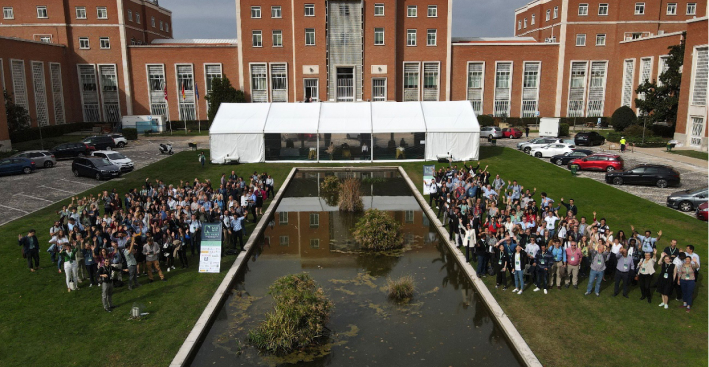Scientific activity and results
Results: This section shows the results of the scientific activity carried out by the AgrosceNa-UP Team aimed at generating scenarios, both for the Spanish case and in an international context, through various collaborations.
Datasets and Spanish scenarios
Fertilization strategies for abating N pollution at the scale of a highly vulnerable and diverse semi-arid agricultural region (Murcia, Spain)
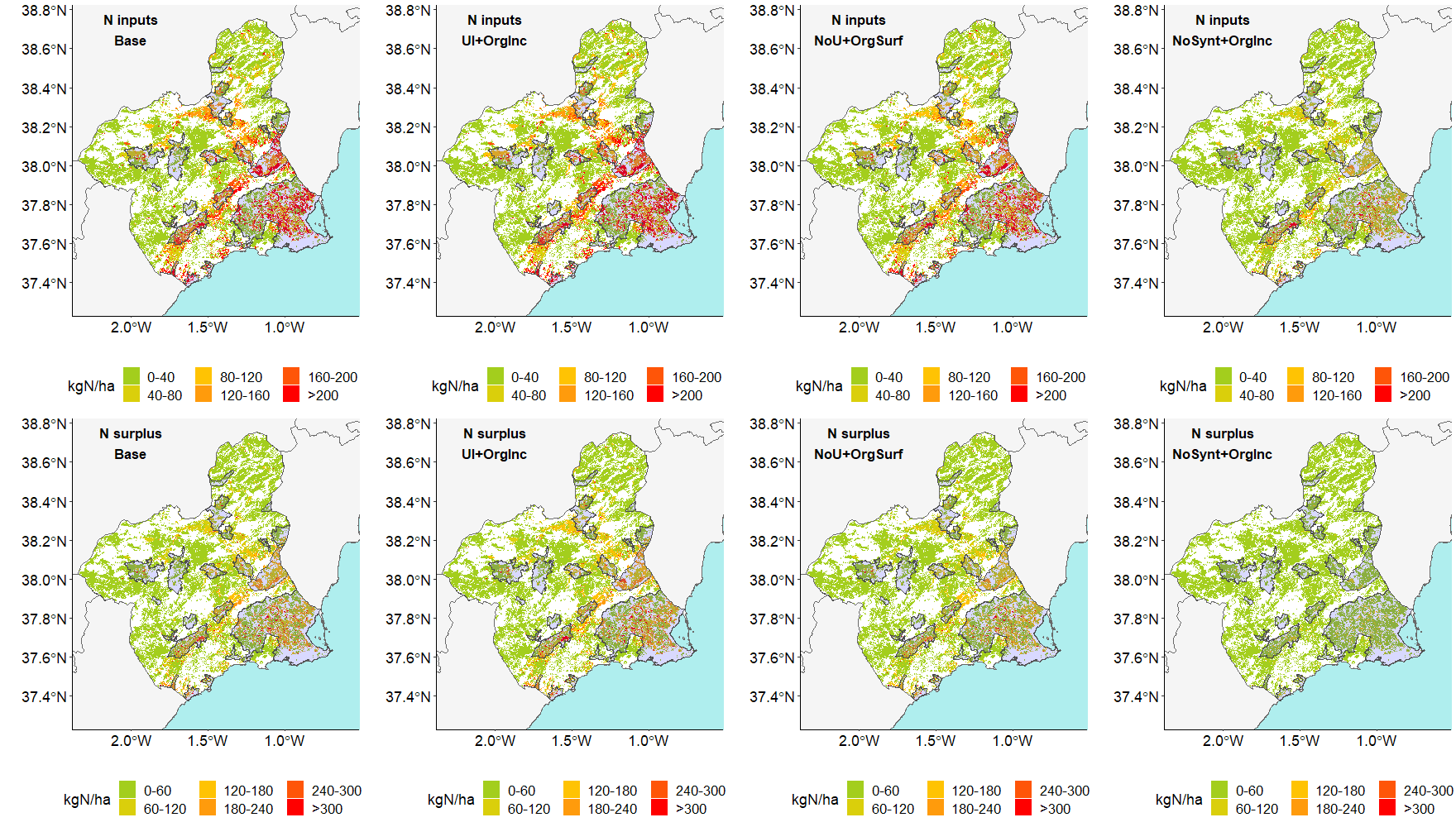
Nitrogen inputs and surpluses in crops in the Murcia region in the base scenario and in 3 alternative fertilization management scenarios. Vulnerable nitrogen zones have been marked in gray.
Sanz-Cobena, A., Lassaletta, L., Rodríguez, A., Aguilera, E., Piñero, P., Moro, M., Garnier, J., Billen, G., Einarsson, R., Bai, Z., Ma, L., Puigdueta, I., Ruíz-Ramos, M., Vallejo, A., Zaman, M., Infante-Amate, J., Gimeno, B.S., 2023. Fertilization strategies for abating N pollution at the scale of a highly vulnerable and diverse semi-arid agricultural region (Murcia, Spain). Environmental Research Letters 18, 064030.
This work analyzes the efficiency of various fertilization strategies to reduce the emission of nitrogen compounds from the cultivation systems to the environment of the Murcia region. The work includes detailed “grid” scales and their integration at the provincial level. The historical evolution of N balances in the long term is analyzed (1860-2018) as well as the N flows between the main compartments of the system. Eight fertilization strategies were established, including the incorporation of manures, the use of urease inhibitors or the elimination of urea, studying the effect at the “grid” or aggregate scale on crop yield and emissions of nitrous oxide, ammonia or nitrate. It is concluded that there is a significant margin for improvement with hardly any penalty in performance.

Nitrogen inputs and surpluses in crops in the Murcia region in the base scenario and in 3 alternative fertilization management scenarios. Vulnerable nitrogen zones have been marked in gray.
Nesting nitrogen budgets through spatial and system scales in the Spanish agro-food system over 26 years
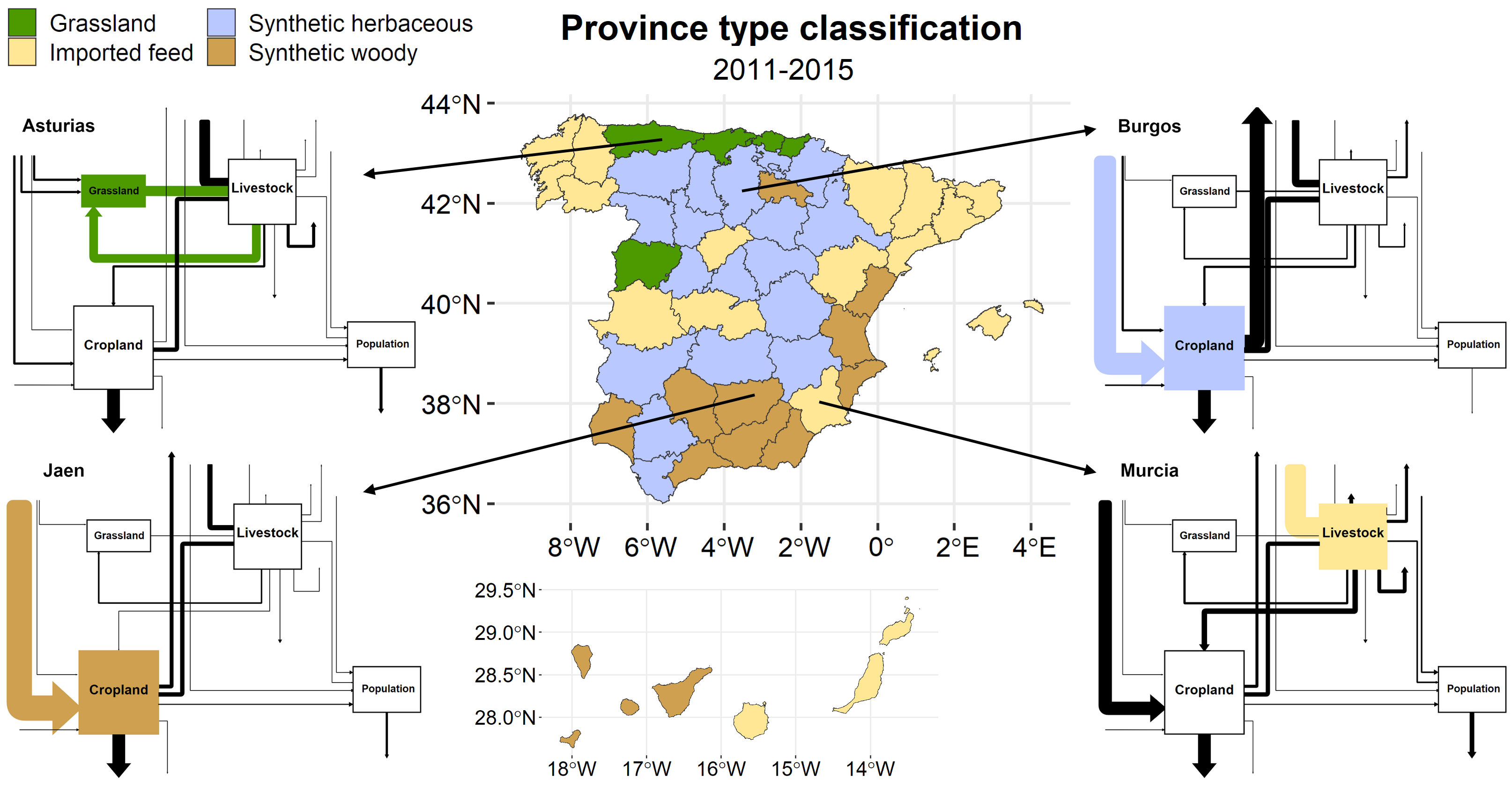
Typologies of the agri-food system of the Spanish provinces: 1) systems activated by the connection between grasslands and livestock; 2) systems activated by the entry of synthetic fertilizer with a majority of herbaceous plants; 3) systems activated by the input of synthetic fertilizer with a majority of woody; 4) systems activated by the net entry of nitrogen embedded in feed.
Rodríguez, A., Sanz-Cobeña, A., Ruiz-Ramos, M., Aguilera, E., Quemada, M., Billen, G., Garnier, J., Lassaletta, L., 2023. Nesting nitrogen budgets through spatial and system scales in the Spanish agro-food system over 26 years. Science of The Total Environment 892, 164467.
In this work, nitrogen flows are estimated and analyzed in the different compartments of the Spanish agri-food system at three system scales (crops, livestock and agri-food system) and two spatial scales (province and country) for 26 years (1990-2015). Nitrogen use efficiency has improved in some crop and livestock systems. However, pollution by N compounds has barely decreased. The Spanish provinces have been classified into four typologies depending on the main source of N that activates the system. A reconnection between crops and livestock has great potential to improve the efficiency of nitrogen use at a system scale, making the country more resilient to rising fertilizer and feed prices.

Typologies of the agri-food system of the Spanish provinces: 1) systems activated by the connection between grasslands and livestock; 2) systems activated by the entry of synthetic fertilizer with a majority of herbaceous plants; 3) systems activated by the input of synthetic fertilizer with a majority of woody; 4) systems activated by the net entry of nitrogen embedded in feed.
Nitrogen dynamics in cropping systems under Mediterranean climate: a systemic analysis
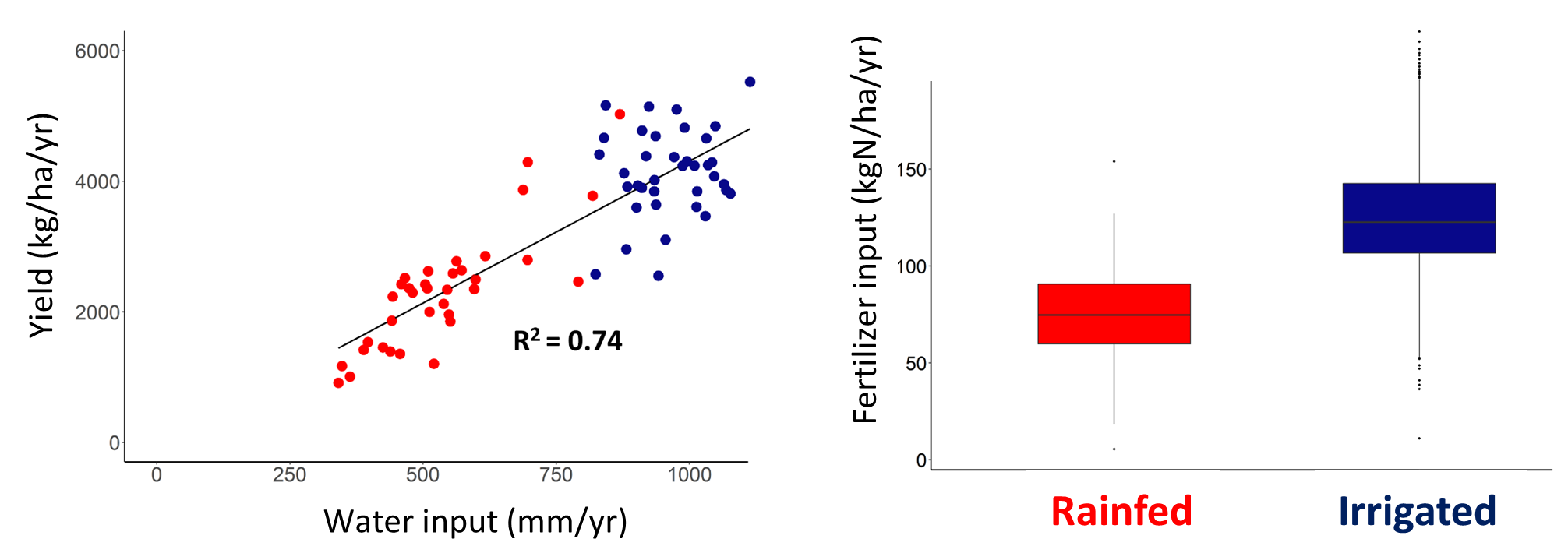
Relationship between water contributions (rain + irrigation) and yield (left panel) and doses of nitrogen fertilization (right panel) in dryland (red) and irrigated (blue) wheat cultivation for 40 Spanish provinces with a Mediterranean climate (1995-2015 ).
Lassaletta, L., Sanz-Cobena, A., Aguilera, A., Quemada, M., Billen, G., Bondeau, A., Cramer, W., Eekhout, J.P.C., Garnier, J., Grizzetti, B., Intrigliolo, D.S., Romero, E., Ruiz-Ramos, M., Vallejo, A., Gimeno, B.S., 2021. Nitrogen dynamics in cropping systems under Mediterranean climate: a systemic analysis. Environmental Research Letters 16, 073002.
In this review, the singularity of cropping systems under a Mediterranean climate is analyzed in their relationship with nitrogen management. The work includes original data analyzing 1) the evolution of the agri-food system of the countries of the Mediterranean basin (1961-2013); 2) the interaction between nitrogen and water through the comparison of irrigated and dryland cereal crops in a Mediterranean aridity gradient, 3) the main determinants that facilitate the emissions of N compounds in their difference with the temperate climate, 4) the connection with the adaptation of cropping systems to climate change; 5) the particularities of the Mediterranean basins in their relationship with nitrate pollution. All these results are analyzed from the perspective of contributing to agro-environmental policies adapted to the particularities of Mediterranean agriculture.

Relationship between water contributions (rain + irrigation) and yield (left panel) and doses of nitrogen fertilization (right panel) in dryland (red) and irrigated (blue) wheat cultivation for 40 Spanish provinces with a Mediterranean climate (1995-2015 ).
Crop production and nitrogen use in European cropland and grassland

Crop areas and nitrogen extraction in some of the countries included in this study (1961-2169). The results obtained are compared with FAOSTAT.
Einarsson, R., Sanz-Cobena, A., Aguilera, E., Billen, G., Garnier, J., van Grinsven, H.J.M., Lassaletta, L., 2021. Crop production and nitrogen use in European cropland and grassland 1961–2019. Scientific Data 8, 288.
This work presents the EuropeAgriDB v1.0 database including detailed information on nitrogen balances in European cropping systems at the country scale for 26 European countries (1960-2019). The balances have been improved by processing information from different databases such as FAOSTAT, Eurostat and also national sources. This work represents an improvement in the detail of the existing information, for example by the inclusion of forage crops, the different types of grasslands and their fertilization.

Crop areas and nitrogen extraction in some of the countries included in this study (1961-2169). The results obtained are compared with FAOSTAT.
Long-term trajectories of the C footprint of N fertilization in Mediterranean agriculture (Spain, 1860–2018)

Greenhouse gas flows, in the crop and upstream and downstream, that have been considered in this work.
Aguilera, E., Sanz-Cobena, A., Infante-Amate, J., García-Ruiz, R., Vila-Traver, J., Guzmán, G.I., González de Molina, M., Rodríguez, A., Piñero, P., Lassaletta, L., 2021. Long-term trajectories of the C footprint of N fertilization in Mediterranean agriculture (Spain, 1860–2018). Environmental Research Letters 16, 085010.
The carbon footprint of crop fertilization has been estimated in Spain and its provinces in the long term (1860-2018). To carry out this work, a detailed database has been developed with information on the management of nitrogen fertilization in 122 rainfed, irrigated and greenhouse crops for 50 provinces. The upstream and downstream emissions of the system have been estimated considering the differences between Mediterranean and temperate climates as well as the evolution of efficiency in fertilizer manufacturing.

Greenhouse gas flows, in the crop and upstream and downstream, that have been considered in this work.
Methods, NUE and budgeting approaches
Drivers of ammonia volatilization in Mediterranean climate cropping systems
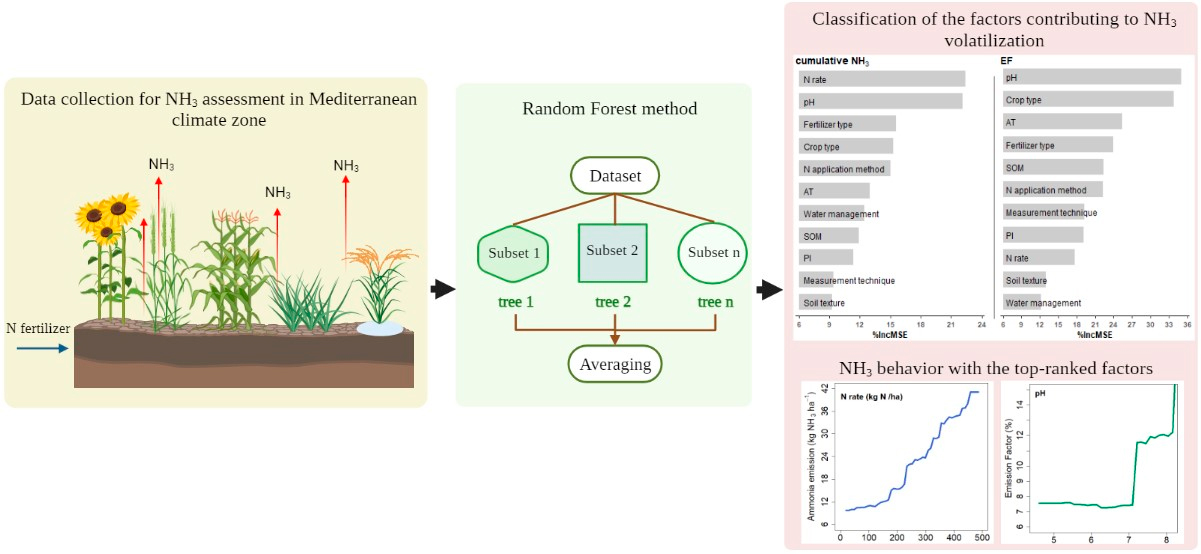
Random Forest carried out to predict ammonia volatilization in Mediterranean crops.
Hurtado, J., Velázquez, E., Lassaletta, L., Guardia, G., Aguilera, E., Sanz-Cobena, A., 2024. Drivers of ammonia volatilization in Mediterranean climate cropping systems. Environmental Pollution 341, 122814.
In this work, a machine learning approach has been used to predict ammonia volatilization in Mediterranean cropping systems based on 234 experimental trial treatments. The “random forest” model had good predictive capacity. Fertilization dose was the main predictor. Unlike in the case of N2O, Mediterranean conditions do not have a particular effect on ammonia emissions. However, there is an indirect effect since Mediterranean systems, mainly rainfed ones, have fertilization doses lower than in temperate systems.

Random Forest carried out to predict ammonia volatilization in Mediterranean crops.
OpenToolFlux: an open-source software for estimating gas fluxes from automatic chamber data
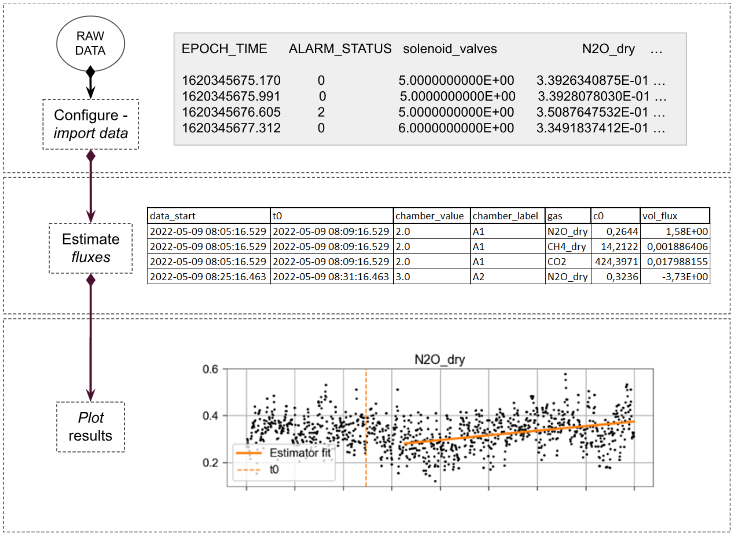
Operation of the OpenToolFlux tool to estimate N2O emissions data in automatic chambers.
Galea, C., Sanz-Cobena, A., Lassaletta, L., Monistrol, A., Vallejo, A. and Einarsson, R. 2023. OpenToolFlux: an open-source software for estimating gas fluxes from automatic chamber data. Agronomy. In press
OpenToolFlux is a tool created to ease the processing of long series of data obtained through the measurement of Greenhouse Gas concentrations by using automatic chambers and analyzers. This equipment is increasingly used in agriculture and allow us to study the impact on the environment. The software transforms the raw data obtained in the field into gas fluxes, facilitating their subsequent analysis.

Operation of the OpenToolFlux tool to estimate N2O emissions data in automatic chambers.
Nitrogen inputs by irrigation is a missing link in the agricultural nitrogen cycle and related policies in Europe
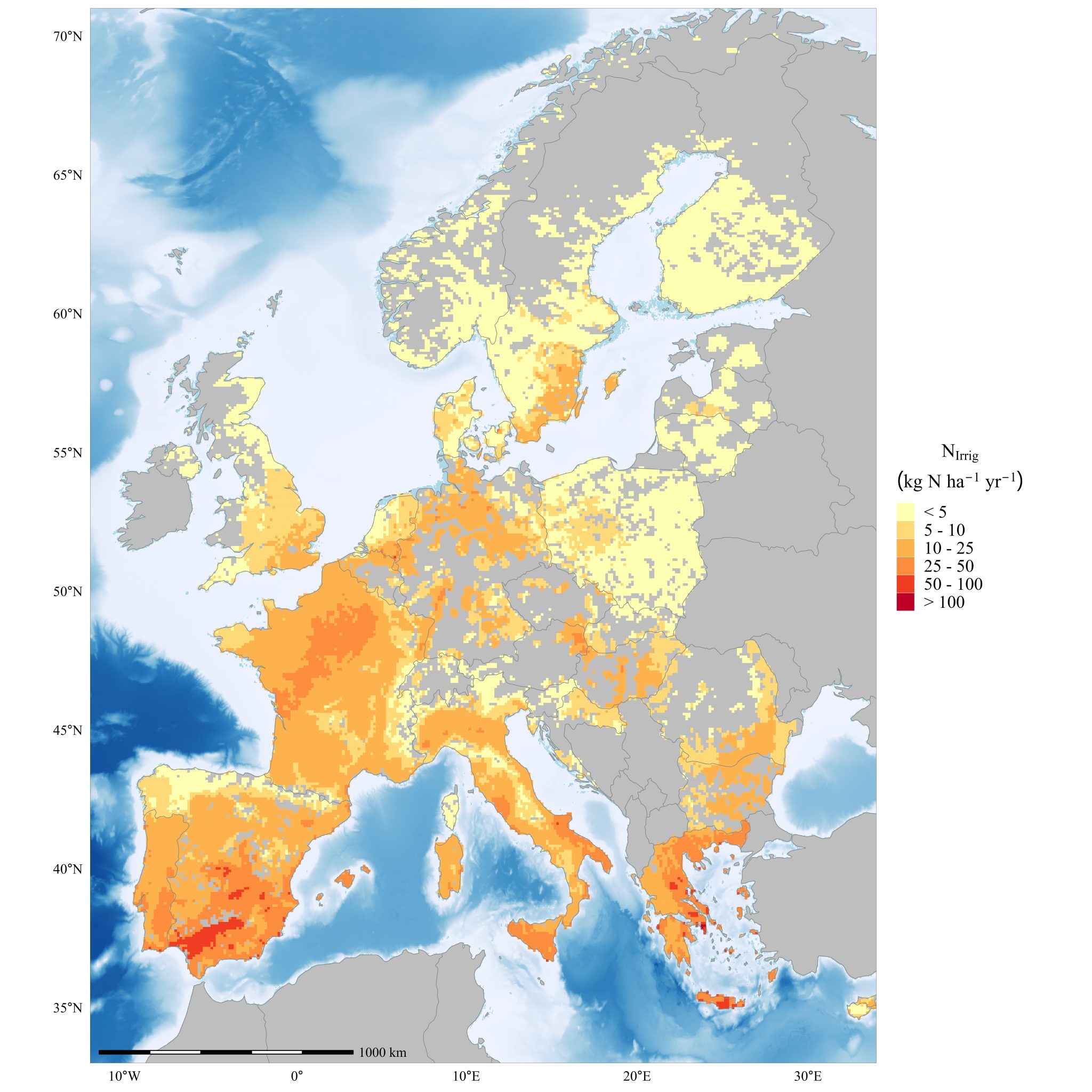
Distribution of nitrogen input per hectare and year in the case of irrigation with the water available for European countries.
Serra, J., Marques-dos-Santos, C., Marinheiro, J., Aguilera, E., Lassaletta, L., Sanz-Cobeña, A., Garnier, J., Billen, G., de Vries, W., Dalgaard, T., Hutchings, N., do Rosário Cameira, M., 2023. Nitrogen inputs by irrigation is a missing link in the agricultural nitrogen cycle and related policies in Europe. Science of The Total Environment 889, 164249.
In this work, the input of nitrogen through irrigation water to European crops is estimated. It is concluded that this entry cannot be ignored. In some cases, the input of N through irrigation can even be equivalent to that of synthetic fertilizer.

Distribution of nitrogen input per hectare and year in the case of irrigation with the water available for European countries.
Quantification of global and national nitrogen budgets for crop production
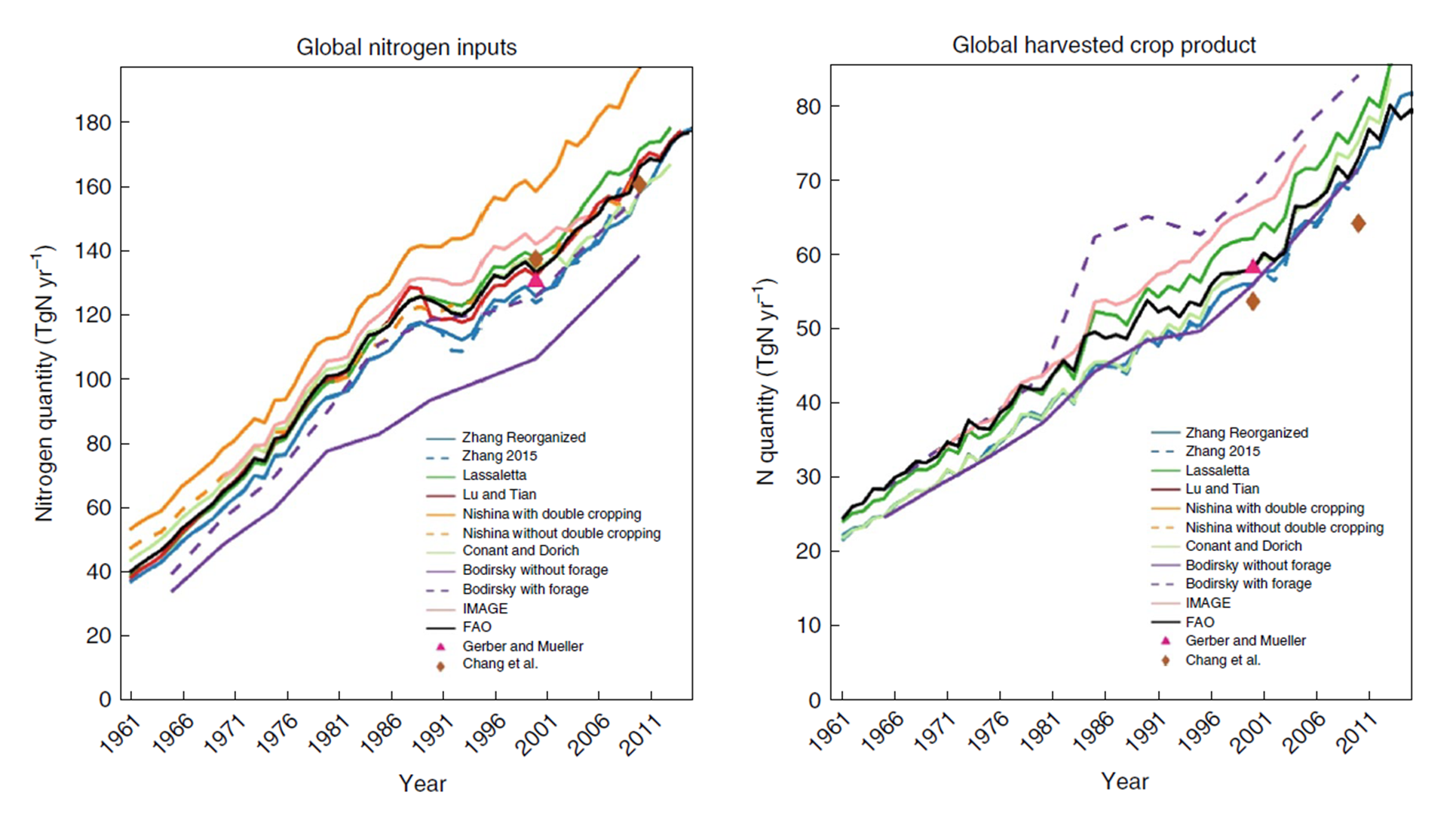
Comparison of nitrogen inputs and extractions in world crops estimated by various research groups for the period 1960-2015.
Zhang, X., Zou, T., Lassaletta, L., Mueller, N.D., Tubiello, F.N., Lisk, M.D., Lu, C., Conant, R.T., Dorich, C.D., Gerber, J., Tian, H., Bruulsema, T., Maaz, T.M., Nishina, K., Bodirsky, B.L., Popp, A., Bouwman, L., Beusen, A., Chang, J., Havlík, P., Leclère, D., Canadell, J.G., Jackson, R.B., Heffer, P., Wanner, N., Zhang, W., Davidson, E.A., 2021. Quantification of global and national nitrogen budgets for crop production. Nature Food 2, 529-540.
In this work, databases of nitrogen balances in cropping systems around the world are compared for the first time on a country scale for 50 years. The different methodologies and approaches are analyzed and the main discrepancies discussed. A new database is proposed. This work represents a significant advance in the harmonization of the efforts carried out by 10 research groups from around the world.

Comparison of nitrogen inputs and extractions in world crops estimated by various research groups for the period 1960-2015.
Regional and global scenarios
How much can changes in the agro-food system reduce agricultural nitrogen losses to the environment? Example of a temperate-Mediterranean gradient
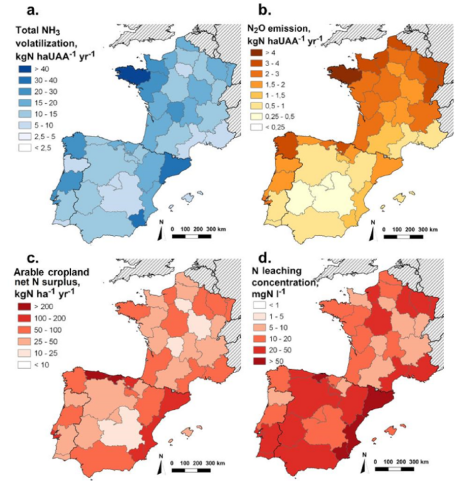
Average emissions of reactive nitrogen compounds in regions of Portugal, Spain and France (NUTS3).
Garnier, J., Billen, G., Aguilera, E., Lassaletta, L., Einarsson, R., Serra, J., Cameira, M.d.R., Marques-dos-Santos, C., Sanz-Cobena, A., 2023. How much can changes in the agro-food system reduce agricultural nitrogen losses to the environment? Example of a temperate-Mediterranean gradient. Journal of Environmental Management 337, 117732.
In this work, very different scenarios are developed for Portugal, Spain and France considering the objectives of the Farm to Fork strategy, “business as usual” scenarios and agroecological configurations for the reduction of nitrate leaching, nitrous oxide and ammonia emissions. A typification of regions at the NUTS3 scale allows us to understand and compare the structure of the agri-food system of each region.

Average emissions of reactive nitrogen compounds in regions of Portugal, Spain and France (NUTS3).
Investing in mini-livestock production for food security and carbon neutrality in China
Bai, Z., Wu, X., Lassaletta, L., Haverkamp, A., Li, W., Yuan, Z., Aguilera, E., Uwizeye, A., Sanz-Cobena, A., Zhang, N., Fan, X., Zhu, F., Dicke, M., Wang, X., Ma, L., 2023. Investing in mini-livestock production for food security and carbon neutrality in China. Proceedings of the National Academy of Sciences 120, e2304826120.
This work analyzes the potential of using insects (“mini-livestock”) for human consumption and as livestock feed to reduce greenhouse gas emissions from the Chinese agri-food system. It is concluded that an increase in its consumption in human and livestock systems will free up land that can be used for reforestation or to capture carbon, significantly reducing greenhouse gas emissions and the need to import feed.
Establishing long-term nitrogen response of global cereals to assess sustainable fertilizer rates
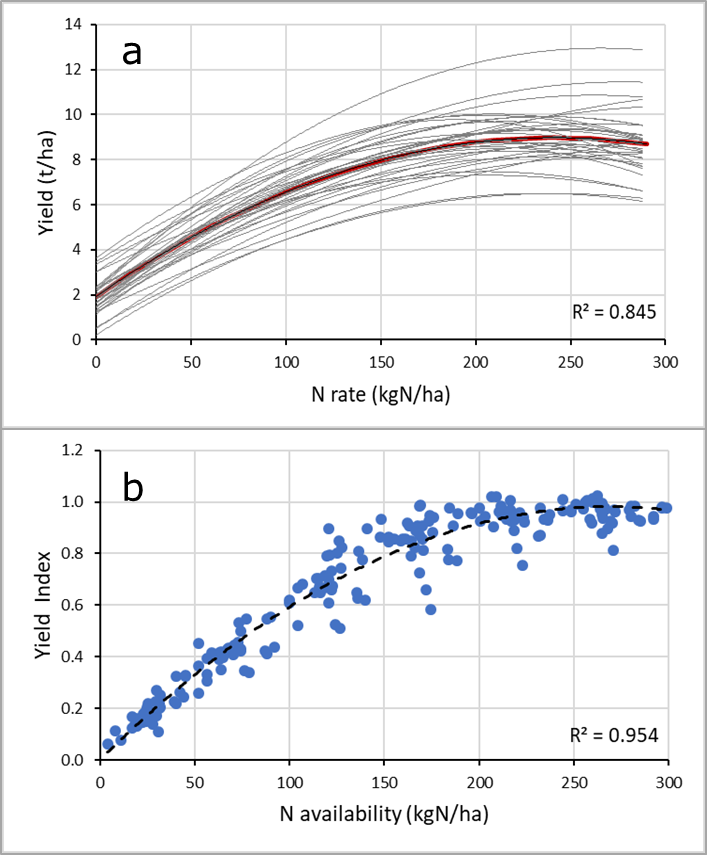
Unscaled response curves (b) and scaled to maximum yield in a wheat crop in the Broadwalk long-term trial (1985-2018).
van Grinsven, H.J.M., Ebanyat, P., Glendining, M., Gu, B., Hijbeek, R., Lam, S.K., Lassaletta, L., Mueller, N.D., Pacheco, F.S., Quemada, M., Bruulsema, T.W., Jacobsen, B.H., ten Berge, H.F.M., 2022. Establishing long-term nitrogen response of global cereals to assess sustainable fertilizer rates. Nature Food 3, 122-132.
In this work, the response of cereals to fertilization is analyzed based on long-term field experiments. It is concluded that the estimated long-term response curves are different from those obtained in short-term trials. The adoption of these curves is recommended in the development of scenarios.

Unscaled response curves (b) and scaled to maximum yield in a wheat crop in the Broadwalk long-term trial (1985-2018).
More efficient phosphorus use can avoid cropland expansion
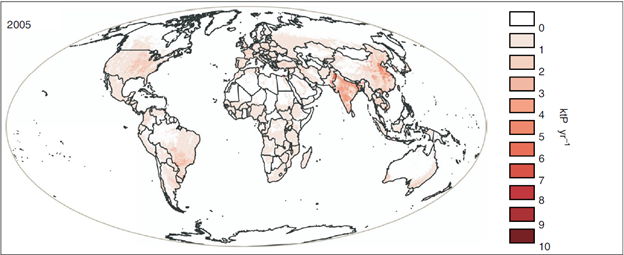
Use of phosphorus fertilizer in 2005.
Mogollón, J.M., Bouwman, A.F., Beusen, A.H.W., Lassaletta, L., van Grinsven, H.J.M., Westhoek, H., 2021. More efficient phosphorus use can avoid cropland expansion. Nature Food 2, 509-518.
In this work, the amount of phosphorus fertilizer that will be necessary to produce food in 2050 is estimated. It is considered that an important part of the added phosphorus (P) is adsorbed or precipitated in the soil and is not available to plants. The P’s legacy is also considered by the model. Various scenarios show the importance of good management that considers the particularity of the soils, the recovery of P from different systems and improving the efficiency of its use.

Use of phosphorus fertilizer in 2005.
Discussion and analysis
Nitrogen use efficiency of tomorrow
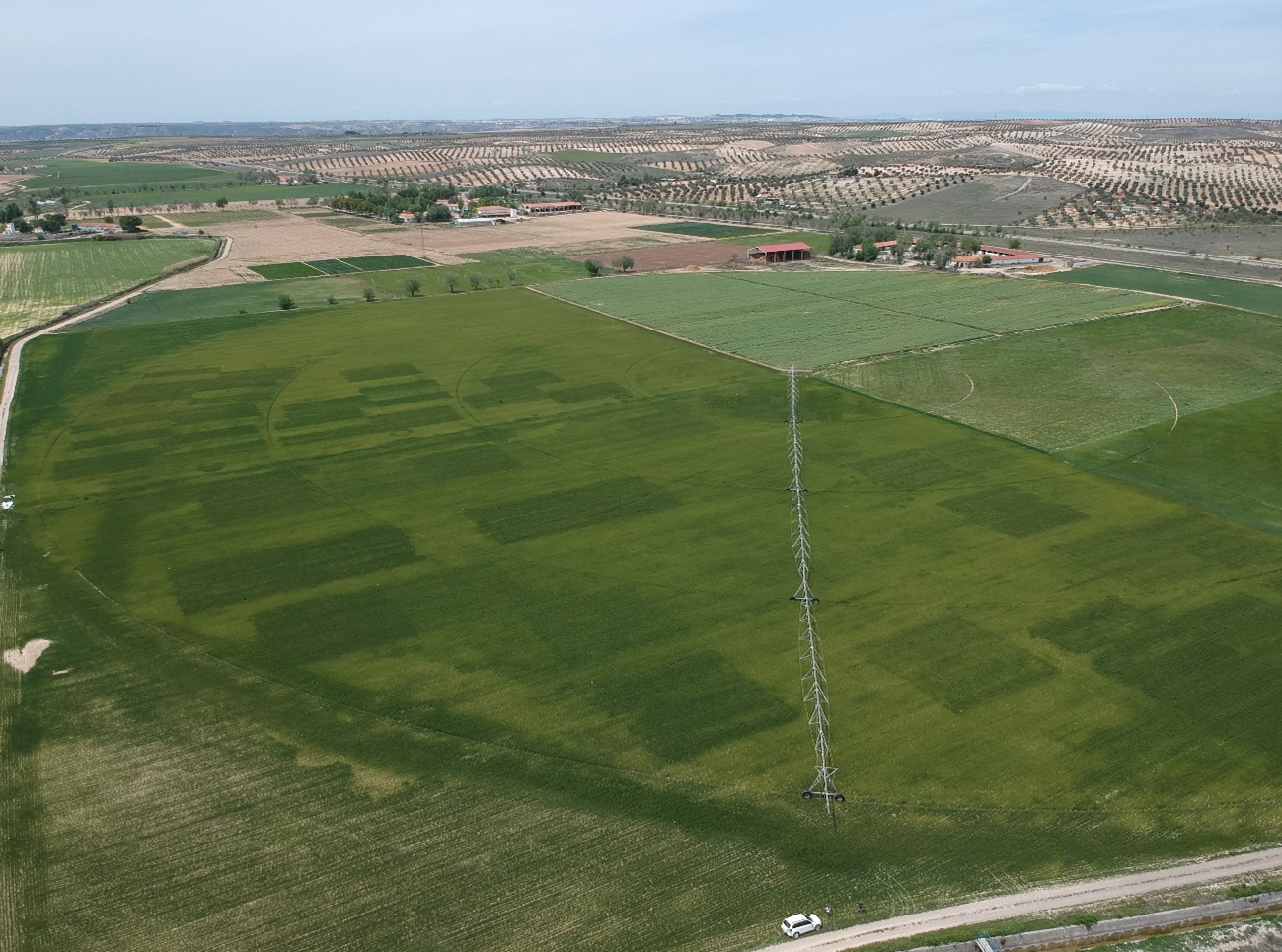
Experiment to study the co-limitation of nitrogen and water with the objective of improving the efficiency of nitrogen use through better management of fertilization and irrigation. (Courtesy of Miguel Quemada).
Lassaletta, L., Einarsson, R., Quemada, M., 2023. Nitrogen use efficiency of tomorrow. Nature Food 4, 281-282.
This opinion article discusses the importance of considering the interaction of water and nitrogen for sustainable resource management. The effect of climate change on nitrogen use efficiency has already been evident in recent decades. Scientists specialized in fertilization and climate must work in coordination to develop systems that mitigate climate change and in turn adapt to it.

Experiment to study the co-limitation of nitrogen and water with the objective of improving the efficiency of nitrogen use through better management of fertilization and irrigation. (Courtesy of Miguel Quemada).
Special numbers
Reducing nitrogen waste through crop and livestock reconnection
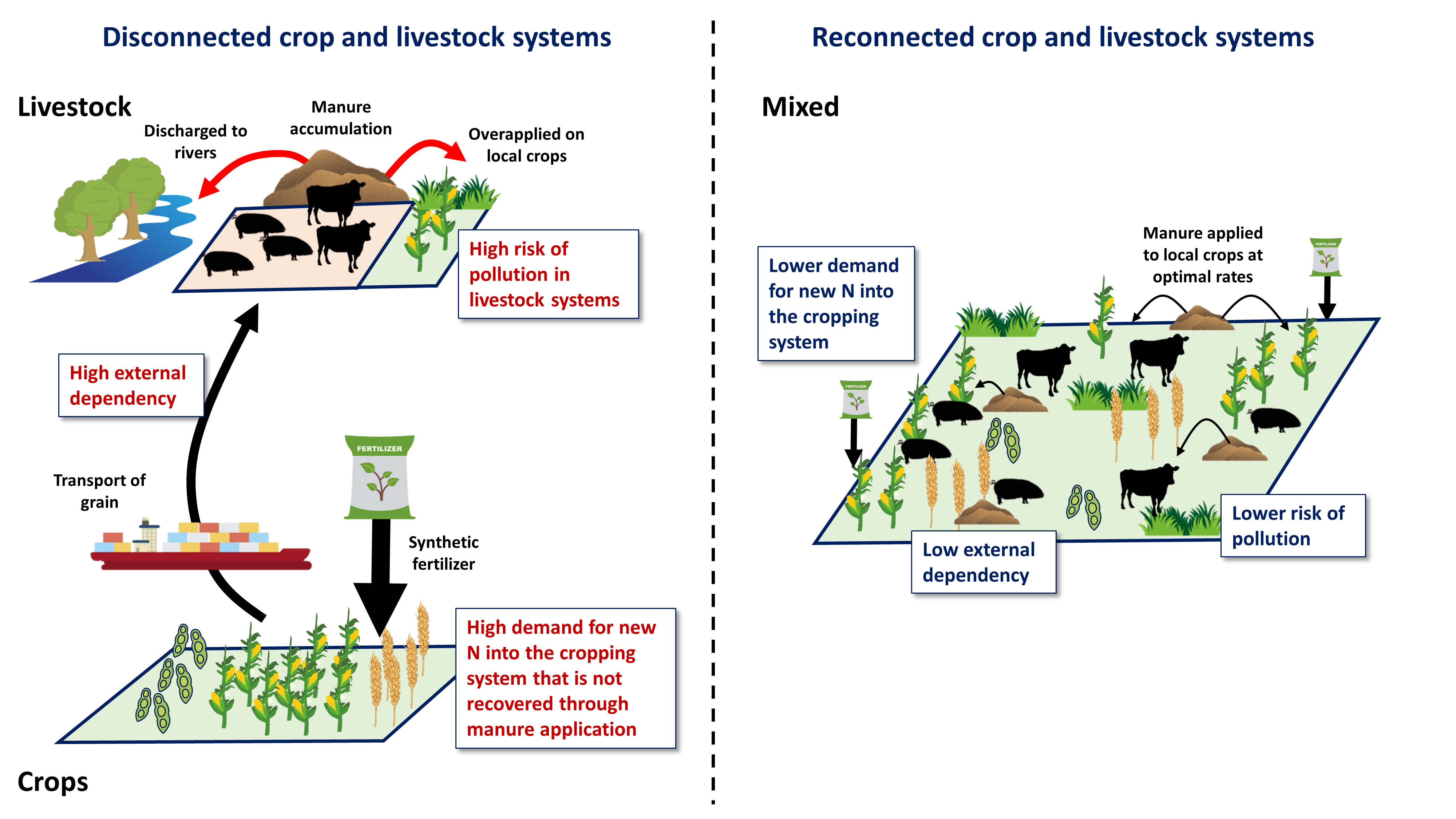
Benefits of crop and livestock reconnection to reduce N waste.
Guest Editors: Luis Lassaletta, Alberto Sanz-Cobeña, Lin Ma, Sherie Spieagal, Corentin Pinsard, Reidsma Pytrik.
Special issue in Agricultural Systems on the reconnection between crops and livestock to reduce nitrogen waste. This special issue is accepting articles that aim to: We can consider studies dealing with strategies to 1) reduce feed imports, thus relocating feed production, 2) improve local and regional optimal allocation of manure, and 3) improve NUE system efficiency through better crop and livestock spatial planning. All the contributions should include an evaluation of the contribution of any change to N waste reduction.

Benefits of crop and livestock reconnection to reduce N waste.
Congress organization
XXI International N Workshop 2022 Madrid
Organization of the XXI International N Workshop (Madrid October 24-28, 2022). More than 300 communications were presented by delegates from 40 countries. The communications included research carried out at different spatial scales (from plot to global) and system scales (crop, livestock, forestry, urban and agri-food system). The program was completed with four special sessions on cost-benefits, agri-environmental policies, remote sensing and circular economy, as well as two round tables and eight keynotes.
Congress coordinators: Alberto Sanz-Cobeña and Luis Lassaletta
